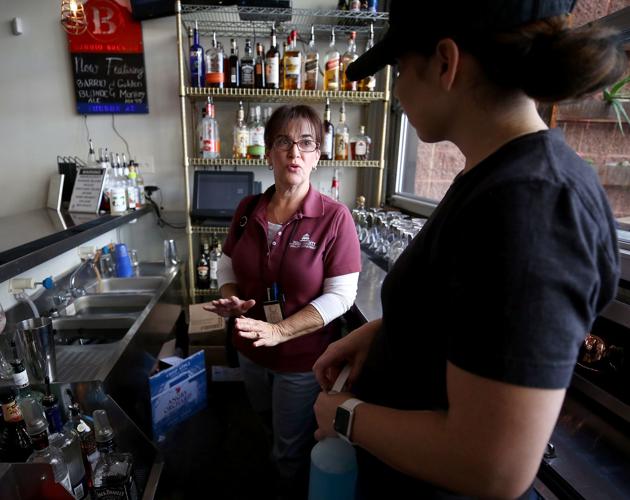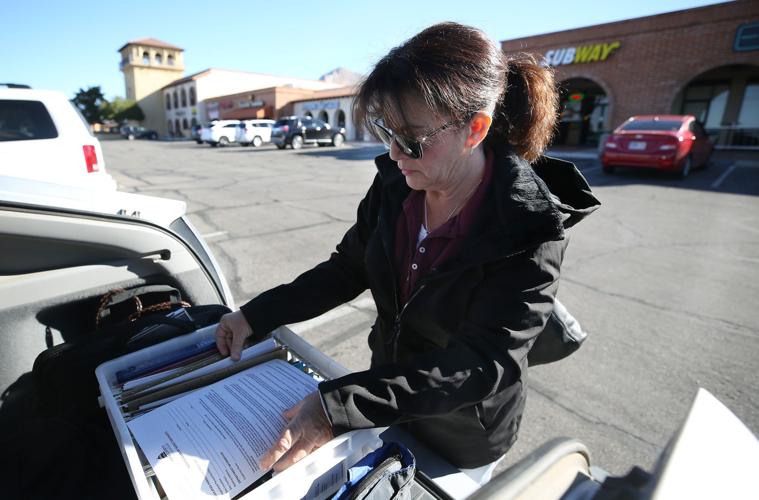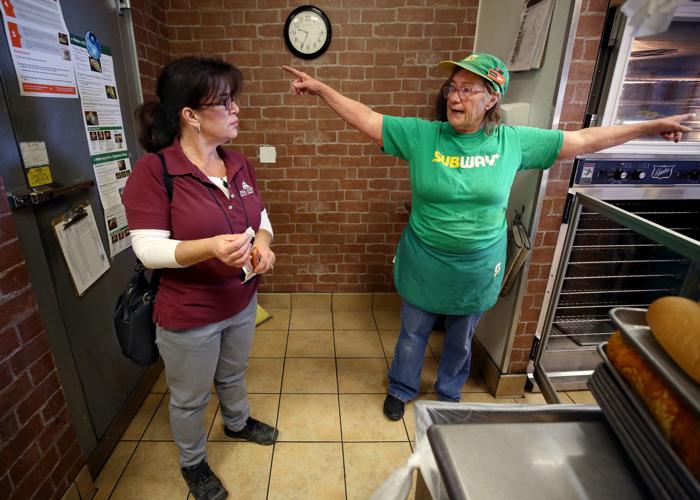In 2015, county health inspector Jim Backus conducted most of the routine restaurant inspections in an area concentrated along North Oracle Road from West River Road north to the county line.
More than 85 percent of the roughly 160 restaurants in that district received an excellent rating, the highest possible, with the remainder getting ratings of good, the second-highest rating. No ratings of “needs improvement” or the more serious “probationary” finding were issued by Backus.
The following year, Backus and fellow inspector Martha Montano split the district almost evenly and, while the restaurants they were inspecting remained largely the same, the results of those inspections changed significantly, indicating that who conducts inspections can impact their outcome, according to a Star analysis of three years of inspection data obtained through public-records requests.

Michele Garsha, a restaurant inspector with Pima County, right, takes a photo of her thermometer as she checks temperatures on food in the freezer in the Subway restaurant, at 7262 North Oracle Road, in Tucson, Ariz., on March 01, 2018.
The number of excellent ratings issued in District 2 fell and the number of good ratings — a step below excellent — rose in 2016. Montano also issued seven needs-improvement ratings, as well as two probationary ratings. Backus, on the other hand, does not appear to have ever issued either probationary or needs-improvement ratings during any of the roughly 1,500 routine inspections he conducted during the three-year period analyzed, placing him on one extreme of a wide range of outcomes seen among county inspectors.
Backus inspected both of the restaurants that Montano failed — a Mexican restaurant and a steakhouse — three times each in 2015, and he awarded excellent ratings on all six occasions, records show. Several months before Montano’s inspections in 2016, he gave the Mexican restaurant and steakhouse good and excellent ratings, respectively.
In 2015, Backus, who retired last October, noted 84 violations during 512 routine inspections. That works out to roughly one for every six visits, the lowest rate that year — a distinction he had for all three years, according to the Star’s analysis. Several other inspectors had comparably low figures in 2015. On average, inspectors noted three violations for every four visits in 2015.
Montano was close to the average in 2017 and 2016, when she was hired. Attempts by the Star to contact Backus were unsuccessful.

Garsha gets her paperwork together before checking a restaurant. There were 29 Health Department employees doing restaurant inspections in 2017, up from 26 in 2015.
On the other end of the spectrum in 2015, there were several inspectors with a sizable number of restaurant visits who noted violations more often than average. Near the top was Danny Nikitas, who averaged 1.52 violations per visit, nearly 10 times Backus’ rate. He also gave excellent ratings in less than half of his routine inspections and probationary ratings at roughly five times the rate of his fellow inspectors.
Comparably wide gaps between the highest and lowest inspector violation rates can be seen in all three years of data, though more inspectors are significantly above the average than below it in 2017. Many, like Montano, are fairly close to averages in all of the years.
The Star described its data analysis to Pima County inspections chief David Ludwig, who said it was “sound.” He said he regularly does comparable calculations and provides them to inspectors “so they can see how they compare to their peers.”
After being provided with some of the analysis, Ludwig later raised concerns that the types of restaurants visited and positions held by the inspectors could explain some of the variations. He said certain classes of establishments are more prone to violations than others and that, if some inspectors were heavily concentrated in certain classes, their inspection results could be skewed.
He also said supervisory inspectors and those with Environmental Health Specialist II positions have “different types of work assignments and therefore do not fit well in the mix” analyzed by the Star.
Additional analysis by the Star in response to his concerns shows that even after considering only lower-level inspectors and certain restaurant classes, significant variation is still seen. For example, in 2017 Soraida Vargas noted an average of 2.69 violations during visits to Class 2 restaurants, which include fast-food establishments, nearly five times the rate of Brian Reeves, who had the second-lowest rate after Backus. Vargas was also much less likely to award excellent ratings and much more likely to award failing probationary ratings than Reeves.

Kathryn Wilkinson, right, manager of a Subway restaurant on North Oracle Road, talks with inspector Michele Garsha.
Given that inspectors are not “robots,” Ludwig said the results were not surprising, though his department is working to improve standardization and consistency. The goal of those efforts is not “to move all inspectors to the middle and being average. It is to train them to recognize violation, ask open-ended questions and make the determination if risks are being addressed,” he said in an earlier email.
“While some restaurants have had some issues with the interpretation of the food code or inconsistencies amongst inspectors, we are confident that these problems can be solved by continuing to work directly with the Pima County Health Department to advance a safe and innovative restaurant industry in the region,” Dan Bogert, the Arizona Restaurant Association’s chief operating officer, said in emailed comments.
Two prominent restaurant owners declined to comment on the record to the Star for this story, with one citing concerns about possible retribution.
Ludwig, who was hired roughly three years ago, said it is his department’s policy for inspectors to note every violation they observe. Whether they actually do so can be difficult to ensure.
“People can pass that standardization process,” he said. “It’s how do we still — without putting a remote camera on them — tell, are they really writing everything down?”
To improve consistency, Ludwig said supervisors are going on ride-alongs with staff workers more frequently to be sure they are conducting inspections properly.
As to what could be behind the discrepancies among inspectors, Ludwig suggested several explanations, but also noted that “there’s always going to be a human factor.”
On the restaurant end, he said the time and date of inspections, as well as who ends up representing the restaurant during the visit, can have a significant impact on results, even if there are no significant changes at the restaurant. Staff-inspector relations can also vary from site to site.
“Everyone has their good places and their bad places and their places they don’t want to go into,” he said. “It’s a stressful situation each and every time you’re there.”
Inspectors with heavier workloads could also be less inclined to write more violations, and vice versa, Ludwig suggested. Additionally, because issuing a needs-improvement or probationary rating requires additional follow-up inspections, there can be a disincentive to not note enough violations for those ratings. However, with additional inspectors on staff and record-keeping improvements that will save inspectors significant time on the horizon, the time pressures that could lead to that behavior should diminish, he said.
There were 29 Health Department employees doing restaurant inspections in 2017, up from 26 in 2015. Inspectors make roughly between $20 and $28 per hour, according to recent county salary data. In 2017, nonsupervisory inspectors conducted an average of 270 restaurant inspections, with some doing fewer than 100 and four with over 500.
Fueled by a sizable grant from the Food and Drug Administration, there is also a redoubled standardization effort underway. Ludwig said they have “put the program on steroids.”
Inspector Erica Lopez, who has been with the department for nearly 15 years, is a key part of that standardization effort, regularly going out with new and seasoned inspectors alike to make sure their inspection practices are up to snuff.
She herself was “standardized” by state officials, and essentially serves as the benchmark for her office. In the three years of data, Lopez was well above the average violations per inspection rate and also gave out fewer excellent ratings and more failing probationary ratings than average.
“I know for myself and for training other inspectors, I make sure that they follow the code, and if they’re seeing the violation, they need to mark the violation,” she said, adding later of the stepped-up standardization effort: “I do think it’s working.”
Ludwig said newer inspectors are more likely than seasoned inspectors to write more violations, a statement reflected in the data. He also said the department is “getting a lot more consistency out of (more recent hires).”
New hires receive up to three months of intensive training and, along with several additional inspectors, are part of the explanation behind rising overall violations, according to Ludwig. A new food code with more potential violations to mark is also likely at play.
Rating shifts have also occurred over the three years.
In 2015, roughly three-quarters of restaurants earned an excellent rating and just 0.66 percent — 48 of over 7,200 routine inspections of permitted restaurants all over the county — got a failing probationary rating. Two years later, just shy of 64 percent of restaurants got excellent ratings, and the percentage of restaurants receiving probationary ratings roughly tripled to 1.8 percent of all inspections, or 131 of nearly 7,300 inspections. Needs improvement ratings more than doubled.
When a restaurant gets a probationary rating, it has to pay an initial fine of $190 and a secondary fine of $380 if there is an additional probationary within 12 months, according to a copy of the county food code.
Asked if the wide range of inspection outcomes between different inspectors could make the process seem unfair to restaurant operators, Ludwig said it is incumbent on businesses to comply with the food code at all times. An inspector who notes all violations makes that easier in the long run than one who may let some things slide.
“Having a Soraida versus a Jim, if she’s writing those violations, then I get them corrected and I keep them corrected, doesn’t that make my place a safer place?” Ludwig said, referring to Backus and Vargas, a newer inspector who had the highest violations per inspection rate among nonsupervisory inspectors in 2017.
The department is also moving inspectors around more frequently, rather than keeping them in areas for a year or more, Ludwig said. That means that even if there are variations among inspectors, those on the extremes like Vargas and Backus won’t be visiting the same restaurants for an extended period.
The goal of all the efforts, Ludwig said, is “everyone getting the same inspection, day in and day out.”






